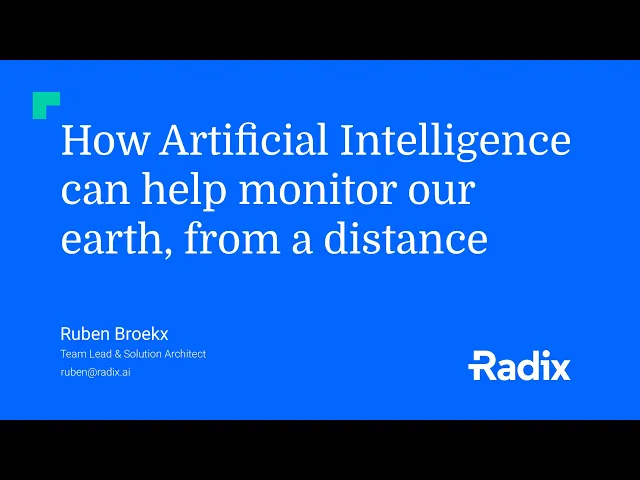
Superlinear’s AI for Sustainability series
Ruben Broekx, a Team Lead and Solution Architect at Superlinear, presented the potential of AI in monitoring our planet from a distance for a more sustainable future. He discussed the applications of remote sensing and machine learning in various use cases ranging from global weather predictions to localized biodiversity assessments, emphasizing the potential of AI in creating a more sustainable world.
Watch his presentation below, or continue reading instead ⬇️
Using remote sensing, we can capture images of the Earth from satellites, drones, or aircraft. Combined with Machine Learning and expert knowledge, these images can provide valuable insights and enable a wide range of use cases. Various stakeholders, from farmers to city planners, can use AI as a copilot in their daily operations and make more informed decisions. Let’s explore this more concretely on three levels: global level, city level, and field level:
Global level
Predicting Extreme Weather Events: By using remote sensing data, machine learning models, and expert knowledge, we can predict extreme weather events such as hurricanes and storms, helping to reduce the loss of lives and property. Companies like Google DeepMind have developed highly accurate weather prediction models like Nowcasting, which provides short-term forecasts, and Graphcast, which provides long-term forecasts. These models help emergency responders and the general public better prepare for potentially hazardous conditions.
City level
Enhancing Urban Sustainability: We can predict heat island effects and air pollution in urban areas by combining on-ground sensors with remote sensing data. This information can help city planners implement targeted interventions like planting trees, installing green roofs, and promoting public transportation to improve urban living conditions, mitigate heat levels, and reduce pollution.
Field level
Biodiversity Assessment: Remote sensing technology, when combined with machine learning and expert knowledge, can help monitor species distribution and habitat mapping more efficiently than manual methods, providing valuable insights for conservation efforts. These techniques assist biologists in making informed decisions on species conservation, enabling better protection of endangered species.
Enhancing Sustainable Agriculture: Remote sensing data, along with machine learning algorithms, can help farmers optimize resource usage and reduce the environmental impact of agriculture. Applications like Farmonaut allow farmers to monitor crop health, apply resources like water and pesticides more efficiently, minimize their climate footprint, and reduce chemical usage. This approach contributes to more sustainable agricultural practices and helps address the challenges of feeding a growing global population.
In conclusion
Remote sensing has immense potential to help us address various sustainability challenges, from global weather prediction to localized agriculture optimization. By harnessing the power of AI, we can make informed decisions and create a more sustainable future for our planet.
Are you ready to welcome AI as your copilot? Don't hesitate to reach out to Superlinear!





